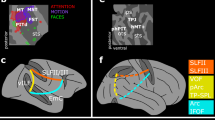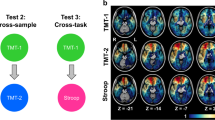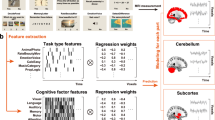Abstract
Cognitive control permits us to make decisions about abstract actions, such as whether to e-mail versus call a friend, and to select the concrete motor programs required to produce those actions, based on our goals and knowledge. The frontal lobes are necessary for cognitive control at all levels of abstraction. Recent neuroimaging data have motivated the hypothesis that the frontal lobes are organized hierarchically, such that control is supported in progressively caudal regions as decisions are made at more concrete levels of action. We found that frontal damage impaired action decisions at a level of abstraction that was dependent on lesion location (rostral lesions affected more abstract tasks, whereas caudal lesions affected more concrete tasks), in addition to impairing tasks requiring more, but not less, abstract action control. Moreover, two adjacent regions were distinguished on the basis of the level of control, consistent with previous functional magnetic resonance imaging results. These results provide direct evidence for a rostro-caudal hierarchical organization of the frontal lobes.
This is a preview of subscription content, access via your institution
Access options
Subscribe to this journal
Receive 12 print issues and online access
$209.00 per year
only $17.42 per issue
Buy this article
- Purchase on Springer Link
- Instant access to full article PDF
Prices may be subject to local taxes which are calculated during checkout




Similar content being viewed by others
References
Badre, D. & Wagner, A.D. Selection, integration and conflict monitoring; assessing the nature and generality of prefrontal cognitive control mechanisms. Neuron 41, 473–487 (2004).
D'Esposito, M. et al. The neural basis of the central executive system of working memory. Nature 378, 279–281 (1995).
D'Esposito, M., Postle, B.R. & Rypma, B. Prefrontal cortical contributions to working memory: evidence from event-related fMRI studies. Exp. Brain Res. 133, 3–11 (2000).
Duncan, J. An adaptive coding model of neural function in prefrontal cortex. Nat. Rev. Neurosci. 2, 820–829 (2001).
Fuster, J.M. The Prefrontal Cortex: Anatomy, Physiology and Neuropsychology of the Frontal Lobe (Lippincott-Raven Publishers, Philadelphia, Pennsylvania, 1997).
Goldman-Rakic, P.S. The prefrontal landscape: implications of functional architecture for understanding human mentation and the central executive. Phil. Trans. R. Soc. Lond. B 351, 1445–1453 (1996).
Koechlin, E. & Summerfield, C. An information theoretical approach to prefrontal executive function. Trends Cogn. Sci. 11, 229–235 (2007).
Miller, E.K. & Cohen, J.D. An integrative theory of prefrontal cortex function. Annu. Rev. Neurosci. 24, 167–202 (2001).
Passingham, R.E. The Frontal Lobes and Voluntary Action. (Oxford University Press, Oxford, 1993).
Passingham, R.E. & Rowe, J.B. Dorsal prefrontal cortex: maintenance in memory or attentional selection? in Principles of Frontal Lobe Function (eds. Stuss, D.T. & Knight, RT.) 221–232 (Oxford University Press, Oxford, 2002).
Petrides, M. Lateral prefrontal cortex: architectonic and functional organization. Phil. Trans. R. Soc. Lond. B. 360, 781–795 (2005).
Shallice, T. & Burgess, P.W. Deficits in strategy application following frontal lobe damage in man. Brain 114, 727–741 (1991).
Smith, E.E. & Jonides, J. Storage and executive processes in the frontal lobes. Science 283, 1657–1661 (1999).
Stuss, D.T. & Benson, D.F. The frontal lobes and control of cognition and memory. in The Frontal Lobes Revisited (ed. Perecman, E.) 141–158 (The IRBN Press, New York, 1987).
Bunge, S.A. How we use rules to select actions: a review of evidence from cognitive neuroscience. Cogn. Affect. Behav. Neurosci. 4, 564–579 (2004).
Carter, C.S. et al. Anterior cingulate cortex, error detection and the on-line monitoring of performance. Science 280, 747–749 (1998).
O'Reilly, R.C. & Frank, M.J. Making working memory work: a computational model of learning in the prefrontal cortex and basal ganglia. Neural Comput. 18, 283–328 (2006).
Courtney, S.M., Roth, J.K. & Sala, J.B. A hierarchical biased-competition model of domain-dependent working memory maintenance and executive control. in The Cognitive Neuroscience of Working Memory (eds. Osaka, N., Logie, R. & D'Esposito, M.) 369–383 (Oxford University Press, Oxford, 2007).
Cohen, J.D., Dunbar, K. & McClelland, J.L. On the control of automatic processes: a parallel distributed processing account of the Stroop effect. Psychol. Rev. 97, 332–361 (1990).
Cohen, J.D. & Servan-Schreiber, D. Context, cortex and dopamine: a connectionist approach to behavior and biology in schizophrenia. Psychol. Rev. 99, 45–77 (1992).
Desimone, R. & Duncan, J. Neural mechanisms of selective visual attention. Annu. Rev. Neurosci. 18, 193–222 (1995).
MacDonald, A.W. III, Cohen, J.D., Stenger, V.A. & Carter, C.S. Dissociating the role of the dorsolateral prefrontal and anterior cingulate cortex in cognitive control. Science 288, 1835–1838 (2000).
Wallis, J.D., Anderson, K.C. & Miller, E.K. Single neurons in prefrontal cortex encode abstract rules. Nature 411, 953–956 (2001).
Botvinick, M.M. Multilevel structure in behaviour and in the brain: a model of Fuster's hierarchy. Philos. Trans. R. Soc. Lond. B Biol. Sci. 362, 1615–1626 (2007).
Botvinick, M.M. Hierarchical models of behavior and prefrontal function. Trends Cogn. Sci. 12, 201–208 (2008).
O'Reilly, R.C., Noelle, D.C., Braver, T.S. & Cohen, J.D. Prefrontal cortex and dynamic categorization tasks: representational organization and neuromodulatory control. Cereb. Cortex 12, 246–257 (2002).
Hazy, T.E., Frank, M.J. & O'Reilly, R.C. Towards an executive without a homunculus: computational models of the prefrontal cortex/basal ganglia system. Philos. Trans. R. Soc. Lond. B Biol. Sci. 362, 1601–1613 (2007).
Badre, D. & D'Esposito, M. Functional magnetic resonance imaging evidence for a hierarchical organization of the prefrontal cortex. J. Cogn. Neurosci. 19, 2082–2099 (2007).
Christoff, K. & Keramatian, K. Abstraction of mental representations: theoretical considerations and neuroscientific evidence. in Perspectives on Rule-Guided Behavior (eds. Bunge, S.A. & Wallis, J.D.) (Oxford University Press, New York, 2007).
Koechlin, E. & Jubault, T. Broca's area and the hierarchical organization of human behavior. Neuron 50, 963–974 (2006).
Koechlin, E., Ody, C. & Kouneiher, F. The architecture of cognitive control in the human prefrontal cortex. Science 302, 1181–1185 (2003).
Badre, D. Cognitive control, hierarchy and the rostro-caudal organization of the frontal lobes. Trends Cogn. Sci. 12, 193–200 (2008).
Buckner, R.L. Functional-anatomic correlates of control processes in memory. J. Neurosci. 23, 3999–4004 (2003).
Fuster, J.M. The prefrontal cortex—an update: time is of the essence. Neuron 30, 319–333 (2001).
Rowe, J.B. et al. Is the prefrontal cortex necessary for establishing cognitive sets? J. Neurosci. 27, 13303–13310 (2007).
Sakai, K. & Passingham, R.E. Prefrontal interactions reflect future task operations. Nat. Neurosci. 6, 75–81 (2003).
Sakai, K. & Passingham, R.E. Prefrontal set activity predicts rule-specific neural processing during subsequent cognitive performance. J. Neurosci. 26, 1211–1218 (2006).
Barbas, H. & Pandya, D.N. Architecture and frontal cortical connections of the premotor cortex (area 6) in the rhesus monkey. J. Comp. Neurol. 256, 211–228 (1987).
Petrides, M. & Pandya, D.N. Efferent association pathways from the rostral prefrontal cortex in the macaque monkey. J. Neurosci. 27, 11573–11586 (2007).
Christoff, K. & Gabrieli, J.D.E. The frontopolar cortex and human cognition: evidence for a rostrocaudal hierarchal organization within the human prefrontal cortex. Psychobiology 28, 168–186 (2000).
Christoff, K., Ream, J.M., Geddes, L.P.T. & Gabrieli, J.D.E. Evaluating self-generated information: anterior prefrontal contributions to human cognition. Behav. Neurosci. 117, 1161–1168 (2003).
Halsband, U. & Passingham, R.E. Premotor cortex and the conditions for movement in monkeys (Macaca fascicularis). Behav. Brain Res. 18, 269–277 (1985).
Hampshire, A., Duncan, J. & Owen, A.M. Selective tuning of the blood oxygenation level-dependent response during simple target detection dissociates human frontoparietal subregions. J. Neurosci. 27, 6219–6223 (2007).
Hampshire, A., Thompson, R., Duncan, J. & Owen, A.M. The target selective neural response–similarity, ambiguity, and learning effects. PLoS ONE 3, e2520 (2008).
Heekeren, H.R., Marrett, S., Bandettini, P.A. & Ungerleider, L.G. A general mechanism for perceptual decision-making in the human brain. Nature 431, 859–862 (2004).
Petrides, M., Alivisatos, B., Evans, A.C. & Meyer, E. Dissociation of human mid-dorsolateral from posterior dorsolateral frontal cortex in memory processing. Proc. Natl. Acad. Sci. USA 90, 873–877 (1993).
Rushworth, M.F. et al. Attentional selection and action selection in the ventral and orbital prefrontal cortex. J. Neurosci. 25, 11628–11636 (2005).
Dreher, J.C., Koechlin, E., Tierney, M. & Grafman, J. Damage to the fronto-polar cortex is associated with impaired multitasking. PLoS ONE 3, e3227 (2008).
Thompson-Schill, S.L. et al. Verb generation in patients with focal frontal lesions: a neuropsychological test of neuroimaging findings. Proc. Natl. Acad. Sci. USA 95, 15855–15860 (1998).
Jeffreys, H. Theory of Probability (Clarendon Press, Oxford, 1961).
Acknowledgements
We are grateful to R.T. Knight and D. Scabini for their help with patient recruitment and lesion characterization. We also would like to thank W. Heindel and A. Kayser for their input on revisions of this manuscript. This work was supported by the US National Institutes of Health (grants MH63901 and NS40813), the Veterans Administration Research Service and a National Research Service Award (F32 NS053337).
Author information
Authors and Affiliations
Corresponding author
Supplementary information
Supplementary Text and Figures
Supplementary Figure 1 and Supplementary Table 1 (PDF 240 kb)
Rights and permissions
About this article
Cite this article
Badre, D., Hoffman, J., Cooney, J. et al. Hierarchical cognitive control deficits following damage to the human frontal lobe. Nat Neurosci 12, 515–522 (2009). https://doi.org/10.1038/nn.2277
Received:
Accepted:
Published:
Issue Date:
DOI: https://doi.org/10.1038/nn.2277
This article is cited by
-
White matter disconnection of left multiple demand network is associated with post-lesion deficits in cognitive control
Nature Communications (2023)
-
Computational models of adaptive behavior and prefrontal cortex
Neuropsychopharmacology (2022)
-
Reward-related choices determine information timing and flow across macaque lateral prefrontal cortex
Nature Communications (2021)
-
Macroscopic gradients of synaptic excitation and inhibition in the neocortex
Nature Reviews Neuroscience (2020)
-
Functional rostro-caudal gradient in the human posterior lateral frontal cortex
Brain Structure and Function (2017)



